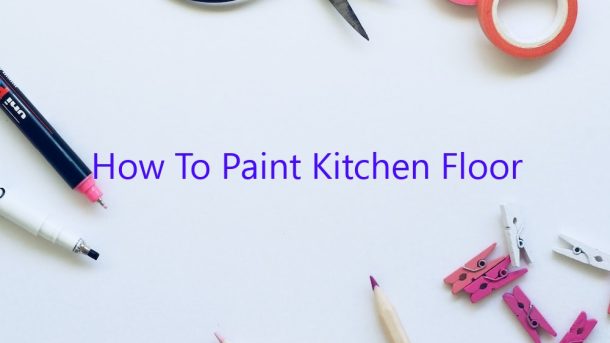How to Paint Your Kitchen Floor
The kitchen floor is often one of the first places that homeowners think to paint, because it can be a big improvement for a relatively small investment. In addition to making your kitchen look fresh and new, painting your kitchen floor can also make it easier to keep clean. Here are some tips on how to paint your kitchen floor:
1. Choose the right paint. When it comes to painting your kitchen floor, it’s important to use a paint that is specifically designed for floors. This will ensure that your floor is properly protected and that the paint will be able to withstand the daily wear and tear.
2. Prep the surface. Before you start painting, it’s important to make sure that the surface is properly prepared. This means cleaning the surface and removing any debris or old paint.
3. Apply the paint. Once the surface is prepared, you can start applying the paint. Be sure to apply it in a thin coat, and make sure to get into all of the nooks and crannies.
4. Let it dry. Once the paint is applied, it will need to dry completely before you can walk on it. This can take anywhere from 24 to 48 hours, depending on the type of paint you use.
5. Seal it. Once the paint is dry, you’ll need to seal it with a coat of sealant. This will help to protect the paint and keep it looking fresh for years to come.
Contents
What kind of paint do you use on a kitchen floor?
When painting a kitchen floor, there are a few things to consider. The first is the type of paint to use. There are a few different types of paint that can be used on a kitchen floor, but the most popular type is an epoxy paint. Epoxy paint is durable and will resist spills and stains. It is also easy to clean, which is important in a kitchen.
Another thing to consider when painting a kitchen floor is the color. The floor should be a color that will coordinate with the cabinets and walls in the kitchen. There are many different colors of epoxy paint available, so it is easy to find one that will match the décor of your kitchen.
Before painting a kitchen floor, it is important to prepare the surface. The floor should be cleaned and free of any dirt or debris. If there are any cracks or holes in the floor, they should be repaired before painting. Once the floor is clean and dry, the epoxy paint can be applied.
Epoxy paint is easy to apply. It can be applied with a brush or a roller. The paint should be applied in thin coats, and it should be allowed to dry completely between coats. It usually takes several coats of paint to cover the entire floor.
Once the paint is dry, the floor can be sealed. Sealing the floor will protect it from spills and stains. There are several different types of sealers available, so it is important to choose one that is appropriate for the type of paint that was used.
painted kitchen floor
What kind of paint do you use on floors?
When it comes to painting your floors, there are a few different things you need to take into consideration. The first is the type of floor you have – is it concrete, wood, or linoleum? The second is the type of paint you should use – there are a variety of paints available, each with its own benefits and drawbacks. In this article, we’ll take a look at the different types of floor paint available and help you decide which is the best option for your home.
Concrete Floor Paint
If you have a concrete floor, you’ll need to use a special type of paint designed for concrete. Concrete floor paint is thicker than other types of paint, and it’s designed to adhere to the concrete surface and resist wear and tear. It’s also non-slip, which is important if you have children or pets.
There are a few different types of concrete floor paint available, including epoxy paint, acrylic paint, and polyurethane paint. Epoxy paint is the most durable, while acrylic paint is the most affordable. Polyurethane paint is a good option if you want to add a gloss or shine to your floor.
Wood Floor Paint
If you have a wood floor, you can use either an oil-based or water-based paint. Oil-based paint is more durable and will last longer, but it’s also more expensive and takes longer to dry. Water-based paint is more affordable and dries faster, but it’s not as durable as oil-based paint.
When choosing a paint for your wood floor, you should also consider the color and finish you want. There are a variety of colors and finishes available, so you can find the perfect one for your home.
Linoleum Floor Paint
If you have a linoleum floor, you should use a water-based paint. Linoleum floor paint is designed to adhere to the surface of the floor and resist wear and tear. It’s also affordable and easy to apply.
When choosing a paint for your linoleum floor, you should consider the color and finish you want. There are a variety of colors and finishes available, so you can find the perfect one for your home.
Is painting your floors a good idea?
Is painting your floors a good idea?
There is no definitive answer to this question. It depends on a variety of factors, including the type of paint you use, the flooring material, and the condition of your floors.
If you are painting a floor that is in good condition and is made from a hard, non-porous material such as concrete, tile, or linoleum, then painting it is probably a good idea. The paint will provide a layer of protection against wear and tear, and it will also make the floor easier to clean.
However, if you are painting a floor that is in bad condition or is made from a porous material such as wood or carpet, then painting it is not a good idea. The paint will not be able to bond properly to the floor, and it will eventually chip and peel.
What is the best Colour for a kitchen floor?
When it comes to kitchen flooring, there are a few things to consider. One of the most important factors is the colour of the floor. The right colour can brighten up a kitchen and make it more inviting, while the wrong colour can make a kitchen seem dark and cramped.
Here are a few tips on choosing the right colour for a kitchen floor:
– The first thing to consider is the overall tone of the kitchen. If the kitchen is light and airy, you’ll want to choose a light or medium-toned floor. If the kitchen is dark and moody, you’ll want to choose a dark or medium-toned floor.
– Another thing to consider is the type of flooring you have. If you have hardwood floors, you’ll want to choose a colour that will complement the wood. If you have ceramic tile or linoleum, you can choose almost any colour you want.
– Finally, think about your personal taste. If you love bright colours, choose a bright floor colour. If you prefer neutrals, choose a light or medium-toned neutral.
Here are a few of the best colours for kitchen floors:
– White is a popular choice for kitchen floors because it brightens up the room and makes it feel larger.
– Beige is another popular choice because it is light and neutral, and it goes with almost any kitchen décor.
– Grey is a popular choice for modern kitchens, and it can make the room appear more sophisticated.
– Brown is a warm and inviting choice that can add some rustic charm to a kitchen.
– Black is a sophisticated choice that can add drama to a kitchen.
– Blue is a popular choice for kitchens with a coastal or nautical theme.
Do painted floors hold up?
Do painted floors hold up? This is a question that many homeowners ask themselves when considering a new paint job. The answer, unfortunately, is not a simple one. There are a number of factors to consider, such as the type of paint used and the condition of the flooring surface.
Painted floors can be a beautiful addition to a home, but they do require some regular maintenance. In order for painted floors to last, the paint must be applied to a smooth, clean surface. If there are any bumps or ridges, the paint will eventually chip and peel.
The type of paint you use is also important. Some paints are more durable than others, and will hold up better against wear and tear. In general, latex paints are more durable than oil-based paints.
If you are considering painting your floor, it is a good idea to test the paint on a small section of the floor first. This will help you to determine whether the paint will hold up over time.
If you already have painted floors and are experiencing problems with chipping or peeling, there are a few things you can do to fix it. One option is to sand down the surface and repaint it. Another option is to apply a coat of sealant to the floor to help protect the paint.
In the end, whether or not painted floors hold up depends on a number of factors. If you are willing to put in the time and effort to maintain them, painted floors can be a beautiful and durable addition to your home.
How long do painted floors last?
How long do painted floors last?
The lifespan of a painted floor can vary significantly depending on the type of paint used, the condition of the substrate, and the amount of traffic the floor receives. In general, a floor that is well-maintained and has a durable paint finish should last for several years.
One of the main benefits of painting a floor is that it can be a cost-effective way to protect and extend the life of a substrate. In comparison to other flooring options, painting is a relatively inexpensive way to cover a floor and can be a great way to brighten up a space.
When it comes to painting a floor, there are a few key things to keep in mind. The most important factor is to choose a paint that is designed for floors and is durable enough to withstand foot traffic. In addition, it is important to properly prepare the substrate before painting. This includes cleaning and sanding the surface to create a smooth, even surface.
Once the floor is painted, it is important to keep it clean and well-maintained. This includes sweeping and vacuuming regularly and occasionally damp-mopping with a mild detergent. If the floor is stained or dirty, it can be cleaned with a non-abrasive cleaner and a soft cloth.
Overall, painting a floor can be a great way to update a space and extend the life of a substrate. With proper maintenance, a painted floor can last for several years.
Do I need to seal a painted floor?
A painted floor can be a beautiful and affordable way to update a room in your home, but it’s important to know how to seal it properly so that it will last. Painted floors can be sealed with a variety of products, but the most popular option is a polyurethane sealer.
Polyurethane sealers come in both water-based and oil-based formulas, and both types have their pros and cons. Water-based polyurethane sealers are easier to apply and are less likely to cause yellowing, but they are not as durable as oil-based polyurethane sealers. Oil-based polyurethane sealers are more durable, but they are harder to apply and can cause yellowing over time.
No matter which type of polyurethane sealer you choose, be sure to follow the manufacturer’s instructions carefully. Also, be sure to test the sealer in a small, inconspicuous area before applying it to the entire floor, as some sealers may cause the paint to fade or chip.
If you decide to seal a painted floor, be sure to use a high-quality polyurethane sealer and follow the manufacturer’s instructions carefully.




